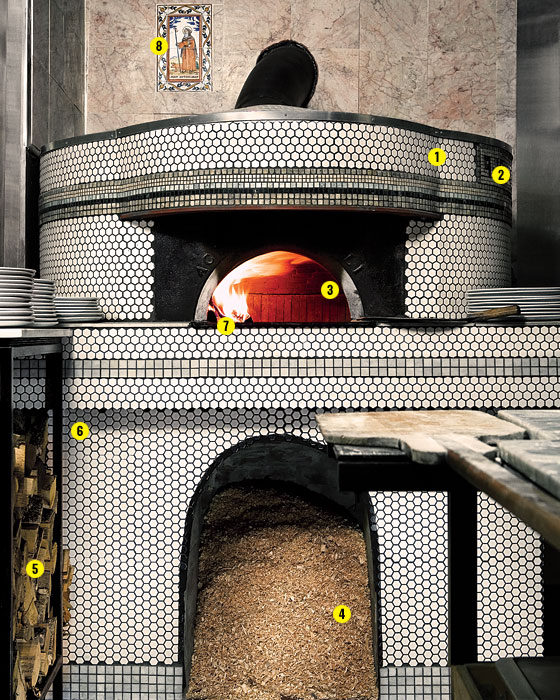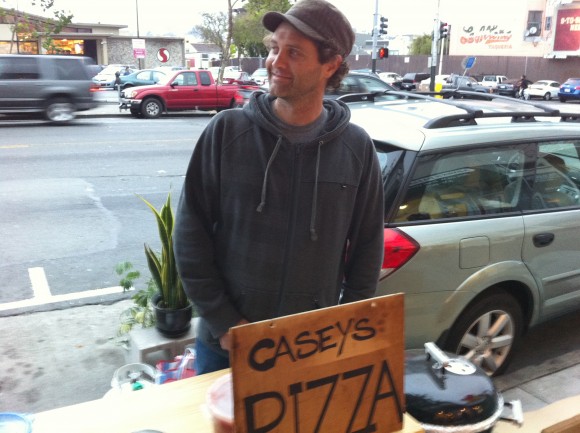Una Pizza Napoletana Opening in San Francisco, Street Food, and Building Your Own Mobile Pizza Cooker
A few weeks ago I traveled to my old home of San Francisco to experience the opening days of an eagerly awaited new pizzeria: Una Pizza Napoletana. The opening was actually the rebirth of what had become a legendary pizzeria in NYC (which had previously existed in NJ), opened in Manhattan in 2004 by Anthony Mangieri (read the writeup from Slice’s first visit to his location, six years ago to the day). Quickly becoming a city-wide phenomenon and then a national point of pizza conversation, Mangieri cemented his place amongst the greats with a strict commitment to excellence and no-nonsense pizzeria approach.

And then, one day in mid-2009, he shut it all down; as Mangieri explained, he always wanted to live in San Francisco, and decided to do just that. The store was sold and reopened as Motorino (still scoring high marks on my NY pizza visits), and the pizza world began to loudly chatter about exactly when and where Anthony would resurface.
As bits of information became available, it looked like San Francisco was indeed the landing point for Mangieri’s next endeavor, which was rumored to carry the same name as it did in Manhattan. Each tidbit of UPN news would work the the foodie community in SF – which is a large and hungry community – into a frenzy of excitement. If there’s one thing that Mangieri has created that is as impressive as his pizzas, it’s the buzz that his presence creates.
Eventually the official location was declared: 11th St and Howard, in a pretty low-key part of the SF Soma district. Opening dates were set for early 2010, but kept getting pushed back as those dates came and passed by. Finally, in early September, the announcement was set: September 15, 2010 would be the opening day.
I drove up to San Francisco the evening of September 16th, hearing stories of 3 hour waits on opening night, the evening before. Having learned my lesson the hard way at Bianco pizzeria in Phoenix (I watched TWO full movies on my laptop while waiting to get seated last year), I made sure to arrive well ahead of time to get seated. First in line almost 90 minutes before opening, which got some funny looks but friendly conversation from the workers as they arrived and cleaned up out front. Thirty minutes before opening, the line began to form, and my pizza pal Noah joined me for the occasion.

The inside of the new UPN is spartan – a big blue orb sits in the center of the room, the gorgeous oven that cooks the pizzas in two minutes or less. Anthony’s pizza counter is directly in front of the oven, with a small metal barrier that invites you to watch the pizza master at work while reminding you to not stand too close. The music is soothingly electronic, reminiscent of the “Naturally Risen” soundtrack by Tommy Guerrero (filmed by Mike Evans, who I had a great conversation with after enjoying my pizza).
The menu, as most followers now know, has just five food items. Five pizzas, and each one is $20. Quite a hefty price to pay for a simple marinara (my pizza of choice) but a lot cheaper than a plane ticket to NY or Italy. We bought the marinara and the margherita and watched with excitement as the first two pizzas of the day were prepared and cooked.
Pizza fanatics like Anthony Mangieri generate so much energy because they are fixated on producing the highest quality pie possible. Top-level flours, tomatoes, toppings. Following the exacting techniques that pizzaolos in Italy live by. And that becomes something that you can taste and feel in your mouth. The pizzas we ordered were fantastic, rich with flavor, wonderfully charred in just the right way. The only thing I wanted more of was oven spring – I like my crust to have a bit of “poof” to it, although Noah felt it was just right.

After we ate, I spoke with Anthony for a few minutes, who despite his intense approach to pizza perfection was wonderfully cordial to discuss the move to SF and the setup of the new place with me. And the next day, as dinner time closed in, I decided to take my pal Grant to have some pizza as well. Anthony told me when I came in that he was feeling great about that day’s batch of dough (a point that we hadn’t discussed the previous day) and he was right – the pies were springier and even more satisfying than the day before.
San Francisco has great food and already had some phenomenal pizzerias. Now they have one (more) of the best.
==========================
On that same trip, I was walking across SF, taking in a few fascinating miles of that great city while heading to a friends house in lower Noe Valley. Along the way, I had another pizza experience in a way that is unique to San Francisco: street food. Over the past couple years, mobile food setups have become popular in various cites. In LA, it started with the Korean taco truck, which became many other types of food trucks, a craze that then spread to other cities. Meanwhile in San Francisco, the food community opted for carts instead of trucks. People began to set up carts to sell gourmet creme brulee and gourmet curry. Not long after that, Pizzahacker turned the pizza world upside down by building his own Weber-mounted wood-fired pizza oven and selling amazing (amazing!) pies to the hungry art, bar, and music patrons around town.

So as I headed south on Mission, around 30th street, I bumped into Casey Crynes of caseyspizza fame. A newcomer on the street food scene in SF, he’s quickly established himself with his drive and enthusiasm. He was set up in front of Secession gallery, the same spot that I spent a night helping Pizzahacker cook pies a few months ago. We chatted about pizza, Una Pizza Napoletana, and San Francisco for a while, and I bought a marinara.
Casey has an interesting setup that is similar yet very different than Pizzahacker’s “PizzaForge” oven. It’s a modified Weber barbeque design set on top of a high output propane burner dubbed the “Little Black Egg,” (LBE) originally designed by pizzamaking.com user named Villa Roma. The original forum thread about this DIY oven became a popular post, with many others following his lead, modifying the design and maximizing the capabilities of the setup. At this point, that original thread is now 50 pages long, which I’ve read all of with quite a bit of enthusiasm. Still, Casey’s setup was the first time I had seen the LBE in person, and I was very impressed. His pizzas were cooking in two minutes, with wonderful amounts of oven spring and charring on the crust. Like all ovens, this design takes a bit of time to learn to control precisely, but it appears that Casey has a good handle on using his well. And what a treat to be able to set the unit up with short notice, to have an easily obtained and maintained source of fuel/fire, and all in a package that is light and easy for transporting.
One great thing about the LBE is that it is a community developed project, which means that there are a lot of resources out there on how to assemble one for yourself. The LBE uses a Weber barbeque, typically the 18″ model, but people have used the larger 22″ model and the smaller 14″ “Smokey Joe” model successfully. A circular area is cut out on the bottom to allow a propane burner to be placed below. Another cutout on the side of the lid creates a vent that pulls the hot air from the fire outwards, running it over the top of the pizza to cook it while the bottom is baking on the stone. On the inside of the lid, a barrier is mounted (small pizza stone, or aluminum platter) to keep the hot air as close to the pizza as possible. And the entire interior of the Weber is lined with heavy duty aluminum foil, which reflects the heat more efficiently than the enamel coating on the grill.

Villa Roma and Jason Molinari have posted very informative and thorough write ups on building a LBE – here are some notes based on the how-to.
You’ll need:
– 18.5″ Weber kettle grill
– 1 6″ unglazed quarry tile (home depot)
– Bayou Classic Burner
– Instant non-contact temperature gun – get a high temperature one (this thing gets hot)
– 15-16″ pizza stone – get a good one, a cheap one WILL break, or some firebricks
– 16″ aluminum pizza pan
– Heavy duty aluminum foil

Cut a 10″ hole on the bottom of the Weber. Make this hole as level as possible, as the barbeque will be sitting on it and cutting it sideways will make the Grill uneven.
Cut a 1″ x 8″ vent hole on the side of the lid.
Drill a hole in the center of the pizza pan and ash catcher, and mount via bolt to the inside of the Weber lid.
Line the interior of lid and barbeque with heavy duty aluminum foil, shiny side facing outwards.

Place the unit on top of the Bayou Burner. Place the stones or bricks on top of the grate (most find that the original grate will sag over time due to the high heat; replacing with a heavy duty unit or a custom piece is common). Position the cooking surface to be closer to vent than to the back so that the heat will have to rise and pass over the pizza in order to vent out of the unit.
Another note on the pizza stone: many have found that a single stone allows too much heat from the burner, which cooks the bottom of the pizza faster than the top, resulting in burnt crusts. The setup that Casey uses with firebricks seems to work well, but this is still a point of much experimentation by LBE builders.

To use the oven, pre-heat with lid on for 20-30 minutes. Lower flame while prepping pizza, place on stone, cover with lid, and turn up the burner to surround the pizza with scorching hot air. Check the pizza a minute into the cooking and rotate as necessary. Make sure to take frequent temperature measurements – the ideal cooking temperature is between 700 and 800 for the both the stone and the inside of the lid.
And if you want to go smaller, LBE creator Villa Roma also has notes on using the 14″ for a “Mini Black Egg” construction.
